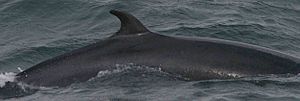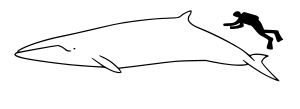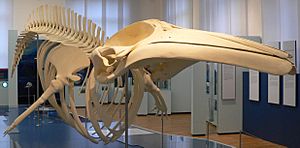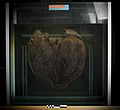Minke whale facts for kids
Quick facts for kids Minke whale |
|
|---|---|
 |
|
| A surfacing minke whale, Skjálfandi, Iceland | |
 |
|
| Size compared to an average human | |
| Conservation status | |
| Scientific classification | |
| Kingdom: | |
| Phylum: | |
| Class: | |
| Order: | |
| Family: | |
| Genus: | |
| Species: |
B. acutorostrata
B. bonaerensis |
The Minke whale is a type of baleen whale. It is one of the smallest baleen whales. These whales live in many parts of the world's oceans. Minke whales are also the smallest rorqual whales. Rorquals are a group of large baleen whales.
A full-grown minke whale can be about 30 feet (9 meters) long. It can weigh around 10 tons (9,000 kg). Minke whales are usually black or gray. They have a white belly. They also have a white band on their flippers, like an "armband." Minke whales can swim very fast. They are the only baleen whales still hunted by humans for their meat and blubber.
There are two main types of minke whales:
- Common minke whale or northern minke whale (Balaenoptera acutorostrata)
- Antarctic minke whale or southern minke whale (Balaenoptera bonaerensis)
Contents
About Minke Whales
Minke whales are the second smallest baleen whale. Only the pygmy right whale is smaller. Male minke whales are about 6.9 m (23 ft) long. Females are a bit longer, around 7.4 m (24 ft). Adult minke whales usually weigh 4 to 5 tons. Some can weigh as much as 14 tons. They become adults when they are 6 to 8 years old.
Minke whales are black, gray, or purple. Common minke whales, found in the Northern Hemisphere, have a white band on each flipper. Their back is usually dark, and their belly is white. When a minke whale comes to the surface to breathe, you can often see its back, dorsal fin, and blowholes all at once.
Minke whales usually live for 30 to 50 years. Some can live up to 60 years.
When a minke whale breathes, it takes three to five quick breaths. Then, it dives deep underwater for two to 20 minutes. Before a deep dive, the whale arches its back a lot. Minke whales can swim very fast, up to 38 km/h (24 mph).
Minke Whale Migration
Both types of minke whales travel long distances. They move to the poles (like the Arctic or Antarctic) in spring. They go to warmer, tropical waters in the fall and winter. This difference in travel times helps keep the two species from mixing too much.
Scientists have studied minke whales off the coasts of British Columbia and Washington. They found that some whales travel as far as 424 km north in spring. They then travel 398 km south to warmer waters in autumn. There is still much to learn about how and why these whales migrate.
Minke Whale Reproduction and Life Cycle
The baby minke whale grows inside its mother for 10 months. When born, calves are about 2.4 to 2.8 m (7.9 to 9.2 ft) long. Newborns drink their mother's milk for five to 10 months. Most breeding happens during the summer. Female minke whales usually have a calf every two years.
The exact time of year for breeding and birth changes depending on where the whales live. For example, in the North Atlantic, most births happen in December. In the Southern Hemisphere, most births happen in July and August.
Minke Whale Predators
Killer whales are known to hunt minke whales. A study in 1975 looked at the stomachs of 49 killer whales. It found that 84% of them had eaten minke whale. When killer whales attack minke whales, they often go for the tongue and lower jaw.
Minke whales try to escape killer whales by swimming away very fast. If they cannot escape, they do not fight back. Chases often lead into the open ocean. Sometimes, minke whales accidentally swim into shallow, trapped waters. There have been two times when minke whales tried to hide under a ship to escape. However, both times they were caught.
What Minke Whales Eat
Minke whales eat different kinds of food depending on where they live.
North Atlantic Diet
In the North Atlantic, minke whales eat many types of food. Before 1993, minke whales in the northern Barents Sea mostly ate small fish called capelin. When capelin numbers dropped, the whales started eating mostly krill. Krill are tiny shrimp-like creatures.
In the Norwegian Sea, minke whales mainly eat adult herring. They also eat krill, capelin, and sand eels. Off the coast of Scotland, sand eels are their favorite food. Herring and sprat are also eaten. Near Finnmark, minke whales eat krill in summer and cod in autumn.
North Pacific Diet
There are two groups of minke whales in the North Pacific. One group (J stock) lives in the Sea of Japan, Yellow Sea, and East China Sea. The other group (O stock) lives in the Okhotsk Sea and West Pacific. Their diet changes with the seasons.
J stock whales mostly eat Japanese anchovy in May and June. They eat pacific saury in July and August. In September, they eat krill. O stock whales mainly eat krill in July and August. In 2002, most minke whales (over 90%) ate only one type of food at a time.
Antarctic Diet
Antarctic minke whales eat during the day. This group of whales mostly eats Antarctic krill in the open ocean. Near the coast, in places like the Ross Sea, they eat ice krill. They have been seen eating ten different species. These include five types of fish, four types of euphausiids (like krill), and one type of amphipod (Themisto gaudichaudii).
Images for kids
See also
 In Spanish: Rorcual Minke para niños
In Spanish: Rorcual Minke para niños







